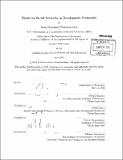Essays on social networks in development economics
Author(s)
Chandrasekhar, Arun Gautham
DownloadFull printable version (15.75Mb)
Other Contributors
Massachusetts Institute of Technology. Dept. of Economics.
Advisor
Abhijit Banerjee, Esther Duflo and Victor Chernozhukov.
Terms of use
Metadata
Show full item recordAbstract
This thesis examines the role that social networks play in developing economies. The first two chapters analyze econometric issues that arise when researchers work with sampled network data. The final two chapters study how the embedding of agents in a network affects a group's ability to overcome weak contracting institutions and what models of social learning are important in describing the diffusion of information. These chapters make use of experiments that I conducted in rural Karnataka, India. The first chapter (co-authored with Randall Lewis) examines the econometric difficulties that applied researchers face when using partially observed network data. In applied work, researchers generally construct networks from data collected from a partial sample of nodes. Treating this sampled network as the true network of interest, the researcher constructs statistics to describe the network or specific nodes and employs these statistics in regression or GMM analysis. This chapter shows that even if nodes are selected randomly, partial sampling leads to non-classical measurement error and therefore bias in estimates of the regression coefficients or GMM parameters. We provide analytical and numerical examples to illustrate the severity of the biases in common applications and discuss possible solutions. Our analysis of the sampling problem as well as the proposed solutions are applied to rich network data of Banerjee et al. (2012) from 43 villages in Karnataka, India. In the second chapter, 1 develop an econometric method to cope with sampled network data. I develop a method, graphical reconstruction, by which a researcher can consistently estimate the economic parameters of interest. Graphical reconstruction uses the available (partial) network data to predict the missing links and uses these predictions to mitigate the biases. As each network may be generated by a different network formation model, the asymptotic theory allows for heterogeneity in the network formation process across graphs. The third chapter (co-authored with Cynthia Kinnan and Horacio Larreguy) analyzes how social networks affect the provision of informal insurance. Social networks are understood to play an important role in smoothing consumption risk, particularly in developing countries where formal contracts are limited and financial development is low. Yet understanding why social networks matter is confounded by endogeneity of risk-sharing partners. This chapter, first, examines the causal effect of close social ties between individuals on their ability to informally insure one another. Second, we examine how the interaction of social proximity and access to savings affects consumption smoothing. Theoretically, they could be complements or substitutes. Savings access may crowd out insurance unless social proximity is high, in which case it benefits the highly connected. Or savings may crowd out risk sharing among the highly connected while helping the less connected smooth risk intertemporally. By conducting a framed field experiment in Karnataka, India, we study the relationships between inability to commit to insurance, ability to save, and social proximity. We find that limited commitment reduces risk sharing, but social proximity (cont.) substitutes for commitment. On net, savings allows individuals to smooth risk that cannot be shared interpersonally, with the largest benefits for those who are weakly connected in the network. The final chapter (co-authored with my classmates Horacio Larreguy and Juan Pablo Xandri) attempts to determine which models of social learning on networks best describe empirical behavior. Theory has focused on two leading models of social learning on networks: Bayesian and DeGroot rules of thumb learning. These models can yield greatly divergent behavior; individuals employing rules of thumb often double-count information and may not exhibit convergent behavior in the long run. By conducting a unique lab experiment in rural Karnataka, India, set up to exactly differentiate between these two models, we test which model best describes social learning processes on networks. We study experiments in which seven individuals are placed into a network, each with full knowledge of its structure. The participants attempt to learn the underlying (binary) state of the world. Individuals receive independent, identically distributed signals about the state in the first period only; thereafter, individuals make guesses about the underlying state of the world and these guesses are transmitted to their neighbors at the beginning of the following round. We consider various environments including incomplete information Bayesian models and provide evidence that individuals are best described by DeGroot models wherein they either take simple majority of opinions in their neighborhood.
Description
Thesis (Ph. D.)--Massachusetts Institute of Technology, Dept. of Economics, 2012. Cataloged from PDF version of thesis. Includes bibliographical references (p. 203-210).
Date issued
2012Department
Massachusetts Institute of Technology. Department of EconomicsPublisher
Massachusetts Institute of Technology
Keywords
Economics.
